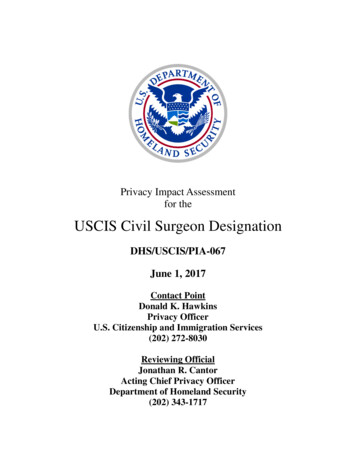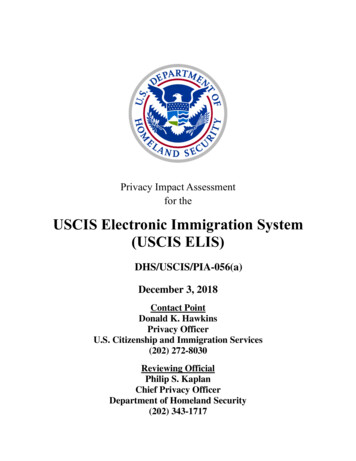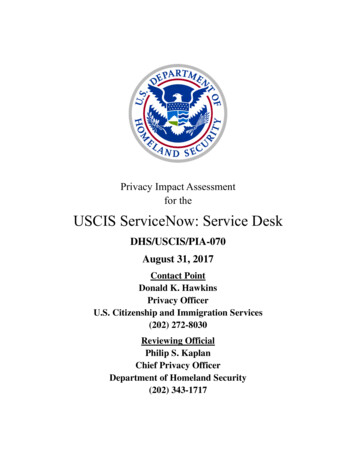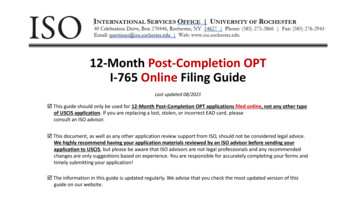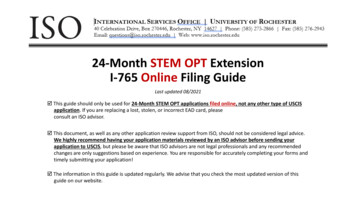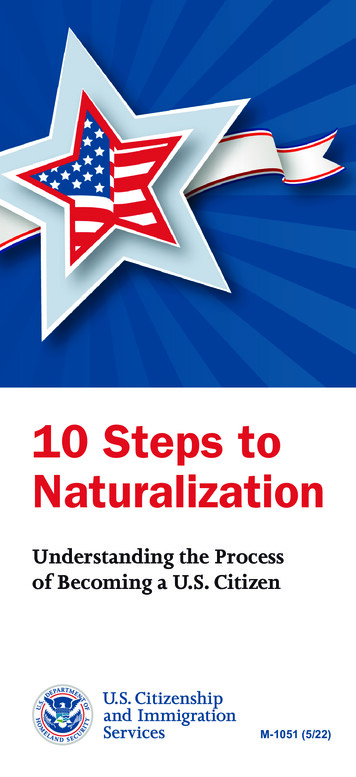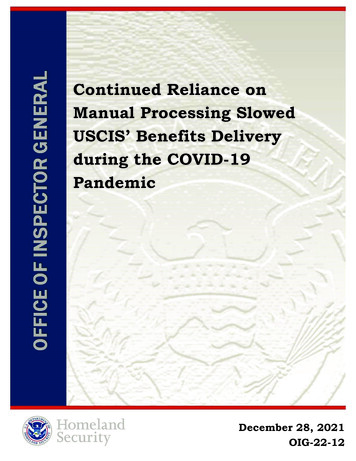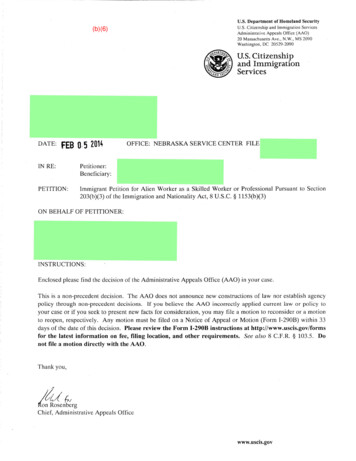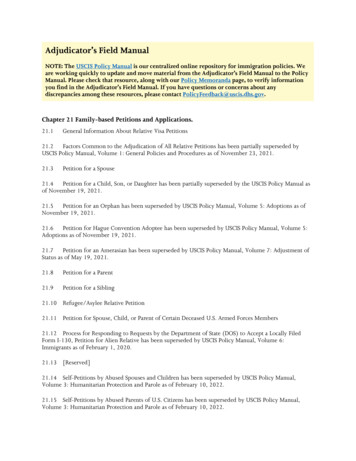
Transcription
Adjudicator’s Field ManualNOTE: The USCIS Policy Manual is our centralized online repository for immigration policies. Weare working quickly to update and move material from the Adjudicator’s Field Manual to the PolicyManual. Please check that resource, along with our Policy Memoranda page, to verify informationyou find in the Adjudicator’s Field Manual. If you have questions or concerns about anydiscrepancies among these resources, please contact PolicyFeedback@uscis.dhs.gov.Chapter 21 Family-based Petitions and Applications.21.1General Information About Relative Visa Petitions21.2 Factors Common to the Adjudication of All Relative Petitions has been partially superseded byUSCIS Policy Manual, Volume 1: General Policies and Procedures as of November 23, 2021.21.3Petition for a Spouse21.4 Petition for a Child, Son, or Daughter has been partially superseded by the USCIS Policy Manual asof November 19, 2021.21.5 Petition for an Orphan has been superseded by USCIS Policy Manual, Volume 5: Adoptions as ofNovember 19, 2021.21.6 Petition for Hague Convention Adoptee has been superseded by USCIS Policy Manual, Volume 5:Adoptions as of November 19, 2021.21.7 Petition for an Amerasian has been superseded by USCIS Policy Manual, Volume 7: Adjustment ofStatus as of May 19, 2021.21.8Petition for a Parent21.9Petition for a Sibling21.10 Refugee/Asylee Relative Petition21.11 Petition for Spouse, Child, or Parent of Certain Deceased U.S. Armed Forces Members21.12 Process for Responding to Requests by the Department of State (DOS) to Accept a Locally FiledForm I-130, Petition for Alien Relative has been superseded by USCIS Policy Manual, Volume 6:Immigrants as of February 1, 2020.21.13 [Reserved]21.14 Self-Petitions by Abused Spouses and Children has been superseded by USCIS Policy Manual,Volume 3: Humanitarian Protection and Parole as of February 10, 2022.21.15 Self-Petitions by Abused Parents of U.S. Citizens has been superseded by USCIS Policy Manual,Volume 3: Humanitarian Protection and Parole as of February 10, 2022.
21.16 Adoption as a Basis for Immigration Benefits has been superseded by USCIS Policy Manual, Volume5: Adoptions as of November 19, 2021.
21.1 General Information About Relative Visa Petitions.(a) Historical Information Regarding Visa Petitions .In the aftermath of World War I, Congress passed a number of laws restricting immigration to the U.S. byboth numbers and qualifications. [Previously, there were restrictions barring certain types of individualsbased on individual shortcomings (e.g., the Act of March 3, 1875 which barred convicts and prostitutes,and the Act of August 3, 1882, which barred criminals, paupers, and “mental and physical defectives”),and on race (i.e., the Chinese Exclusion Act of May 6, 1882).] In order to qualify for an imm igrant visa(itself a new post-WWI innovation), the alien had to fall within one of the quota categories, or be exempttherefrom. The visa petition was then created as the vehicle for establishing that an alien fell into one of thehigher quota categories, or was quota-exempt.Over the years, the definitions of the various immigrant visa categories have changed with the passage ofnew legislation, and the requirements have been interpreted and reinterpreted through volumes of caselaw. However, the need for an approved immigrant visa petition to qualify for most visa classifications hasremained a basic requirement of the system of legal immigration to the United States. It is no exaggerationto say that professional adjudication of immigrant visa petitions is one of the keystone s to ensuring that thesystem works as intended.(b) Organization of This Chapter .Many of the basic visa petition adjudication procedures and issues are similar regardless of the form beingfiled or the classification being sought. Those basic procedures are discussed in subchapter21.2 . Subchapters 21.3 through 21.10 are organized according to the relationship of the petitioner to thebeneficiary and discuss those aspects of the adjudication procedures and issues which are unique to thoseparticular relationships. Accordingly, it is intended that the users of this field manual review bothsubchapter 21.2 and the relevant individual relationship subchapter when seeking information.(c) Special Parole and Deferred Action Considerations.On November 15, 2013, USCIS, pursuant to the authority conferred upon the Secretary of HomelandSecurity by INA § 212(d)(5)(A), 8 U.S.C. § 1182(d)(5)(A), issued a Policy Memorandum guiding theexercise of discretion with respect to applications for parole by designated family members of U.S. militarypersonnel and veterans. On November 20, 2014, the Secretary directed USCIS to issue new policies on theuse of both parole in place and deferred action for certain family members of certain military personnel,veterans, and individuals who are seeking to enlist in the U.S. military. See Secretary of Homeland SecurityMemorandum, "Families of U.S. Armed Forces Members and Enlistees" (Nov. 20,2014), s/14 1120 memo parole in place.pdf
These new policies support the Department of Defense (DoD) in several ways, including by: Elaborating on general USCIS deferred action policies by identifying factors that are of particularrelevance to discretionary determinations involving military personnel, veterans, and their families; Building on existing USCIS and DoD initiatives and policies designed to assist military members,veterans, and their families in navigating our complex immigration system; Facilitating military morale and readiness and supporting DoD recruitment policies by consideringtemporarily deferring the removal of certain military family members; Furthering the goal of the Military Accessions Vital to the National Interest (MAVNI) program torecruit certain foreign nationals whose skills are considered vital to the national interest and criticalto military services; and Ensuring consistent support for our military personnel and veterans, who have served andsacrificed for our nation, and their families.For guidance on parole in place for certain family members of military personnel and veterans, see AFMChapter 21.1(c)(1). For guidance on deferred action for certain enlistees and certain family members ofmilitary personnel and veterans, see AFM Chapter 21.1(c)(2).(1) Special Parole Consideration for Spouses, Parents, Sons, and Daughters of Active Duty Members of theU.S. Armed Forces, Individuals in the Selected Reserve of the Ready Reserve, or Individuals Who (WhetherStill Living or Deceased) Previously Served on Active Duty in the U.S. Armed Forces or the Selected Reserveof the Ready Reserve and Were Not Dishonorably Discharged.The decision whether to grant parole under INA § 212(d)(5)(A) is discretionary. Generally, USCIS grantsparole in place only sparingly. The fact that the individual is a spouse, parent, son, or daughter of an ActiveDuty member of the U.S. Armed Forces, an individual in the Selected Reserve of the Ready Reserve, or anindividual who previously served on active duty in the U.S. Armed Forces or the Selected Reserve of theReady Reserve (if the former service member was not dishonorably discharged and either is living or diedwhile the family member was residing in the United States), however, ordinarily weighs heavily in favor ofparole in place. Absent a criminal conviction or other serious adverse factors, parole in place wouldgenerally be an appropriate exercise of discretion for such an individual. If USCIS decides to grant parole inthat situation, the parole should be authorized in one-year increments, with extensions of parole asappropriate. To request parole, the alien must submit to the director of the USCIS office with jurisdictionover the alien's place of residence: Completed Form I-131, Application for Travel Document (The USCIS Director has determined thatin this situation the Form I-131 may be filed without fee, per 8 CFR 103.7(d)); Evidence of the family relationship (this may include proof of filing a petition in certain cases – seeAFM 21.1(c)(3) below); Evidence that the alien's family member is an Active Duty member of the U.S. Armed Forces,individual in the Selected Reserve of the Ready Reserve, or an individual who (whether still livingor deceased) previously served on active duty in the U.S. Armed Forces or the Selected Reserve orthe Ready Reserve such as a photocopy of both the front and back of the service member's militaryidentification card (DD Form 1173) (in the case of family members of veterans (whether still
living or deceased), the service member must not have received a dishonorable discharge uponseparation from the military) In the case of surviving family members, proof of residence in the United States at the time of theservice member’s death; Two identical, color, passport style photographs; and Evidence of any additional favorable discretionary factors that the requestor wishes considered.Individuals who have obtained parole in place are eligible to apply for work authorization for the period ofparole if they can demonstrate economic necessity. See 8 CFR 274a.12(c)(11), (14). See Form I-765,Application for Employment Authorization.Parole in place may be granted only to individuals who are present without admission and are thereforeapplicants for admission. Individuals who were admitted to the United States but are currently present inthe United States beyond their periods of authorized stay are not eligible for parole in place, as they are nolonger applicants for admission.(2) Deferred Action Consideration for Spouses, Parents, and Sons and Daughters of Active Duty MilitaryPersonnel, Individuals in the Selected Reserve of the Ready Reserve, and Individuals Who (Whether StillLiving or Deceased) Previously Served on Active Duty in the U.S. Military or the Selected Reserve of theReady Reserve and Were Not Dishonorably Discharged; and for MAVNI and other Enlistees in the DelayedEntry Program and their Spouses, Parents, and Sons and Daughters.(A) Deferred Action for DoD Delayed Entry Program Enlistees (Including MAVNI Recruits) and CertainFamily Members.Individuals who have no previous military experience and are seeking to enlist in the U.S. Armed Forcesmust sign a contract by which they enter into the Delayed Entry Program (DEP) for a maximum of 365days while awaiting Basic Training. While in the DEP, there can be delays in starting active duty for theActive Components or initial active duty for training for the Reserve Components.Individuals who enlist in the military through the Military Accessions Vital to the National Interest(MAVNI) program may also enter the DEP. The MAVNI program allows certain foreign nationals to enlistin the military to fill positions where there are critical shortages in health care and foreign language skills.See the DoD MAVNI program fact sheet for further details: st MAVNI recruits are in a lawful nonimmigrant status at the time that they enlist. For example, it iscommon for a J-1 foreign exchange visitor or F-1 foreign student to enlist in the U.S. military throughMAVNI. Through no fault of their own, MAVNI recruits in the DEP may fall out of their lawful status whilewaiting to enter Basic Training. This may occur, for example, in cases where an F-1 foreign studentcompletes his or her program of study while waiting to enter Basic Training in the DEP. In the same way,the family members of such recruits often lose their lawful statuses because their statuses depend on thoseof the recruits. In addition, family members might lack status either because they are present without beingadmitted or paroled, or because they were admitted or paroled but overstayed their authorized periods ofstay even before their MAVNI or other DEP family member entered the DEP.
As in all deferred action determinations, USCIS will make case-by-case, discretionary judgments based onthe totality of the evidence. In doing so, USCIS will weigh and balance all relevant considerations, bothpositive and negative. Certain factors, however, are of particular relevance to the exercise of that discretionwhen deferred action requests are submitted by individuals in DEP and their family members. Particularlystrong positive factors specific to such requests include, but are not limited to: Being a DEP enlistee, including through the MAVNI program (even if the enlistee’s authorizedperiod of stay expires while in the DEP); and Being the spouse, parent, son, or daughter of a MAVNI recruit or other individual in the DEP (evenif present in the United States without an authorized status).The presence of one or more of the preceding factors does not guarantee a grant of deferred action but maybe considered a strong positive factor weighing in favor of granting deferred action. The ultimate decisionrests on whether, based on the totality of the facts of the individual case, USCIS finds that the positivefactors outweigh any negative factors that may be present.If an individual described in either of the two bullets above is granted deferred action in the exercise ofdiscretion, the period of deferred action should be authorized in two-year increments; USCIS may considerrequests for renewal of deferred action as appropriate. If the individual withdraws from the DEP orbecomes disqualified from joining the military, any period of deferred action for the family member maybe terminated. See AFM Chapter 21.1(c)(2)(C) for guidance on filing requests for deferred action. See AFMChapter 21.1(c)(1) for guidance on parole in place.(B) Deferred Action for Certain Family Members of Active Duty Members of the U.S. Military, Individualsin the Selected Reserve of the Ready Reserve, or Individuals Who (Whether Still Living or Deceased)Previously Served on Active Duty in the U.S. Military or in the Selected Reserve of the Ready Reserve andWere Not Dishonorably Discharged.As in all deferred action determinations, USCIS will make case-by-case, discretionary judgments based onthe totality of the evidence. In doing so, USCIS will weigh and balance all relevant considerations, bothpositive and negative. Certain factors, however, are of particular relevance to the exercise of that discretionwhen deferred action requests are submitted by the family members of military personnel and veterans.One particularly strong positive factor specific to such requests is that the person has been admitted and isthe spouse, parent, son, or daughter of an individual who is serving, or has previously served on activeduty in the U.S. military or in the Selected Reserve of the Ready Reserve (if the former service member wasnot dishonorably discharged and either is living or died while the family member was residing in theUnited States). Such an individual ordinarily fits the guidelines for parole under section 21.1(c)(1) above,except for being statutorily ineligible solely because of his or her prior admission. See INA §§212(d)(5)(A), 235(a)(1), 8 U.S.C. §§ 1182(d)(5)(A), 1225(a)(1). The presence of the preceding factordoes not guarantee a grant of deferred action but may be considered a strong positive factor weighing infavor of granting deferred action. The ultimate decision rests on whether, based on the totality of the factsof the individual case, USCIS finds that the positive factors outweigh any negative factors that may bepresent. If USCIS grants deferred action in the exercise of discretion, the period of deferred action shouldbe authorized in two-year increments; USCIS may consider requests for renewal of deferred action asappropriate.(C) Filing Request for Deferred Action.
To request deferred action, one must submit the following to the director of the USCIS office withjurisdiction over the requestor’s place of residence: Letter stating basis for the deferred action request [See AFM 21.1(c)(2)(A) and (c)(2)(B)]; Evidence supporting a favorable exercise of discretion in the form of deferred action as elaboratedin AFM 21.1(c)(2)(A) and (c)(2)(B) – (e.g., evidence of family member’s current or previousmilitary service, or alien’s or family member’s enlistment in the DEP; note that in the case of familymembers of veterans, whether still living or deceased, the service member must not have receiveda dishonorable discharge upon separation from the military); Proof of family relationship, if applying based on family relationship to military member, veteran,or enlistee (this may include proof of filing a petition in certain cases - see section below); In the case of surviving family members, proof of residence in the United States at the time of theservice member’s death; Proof of identity and nationality (including a birth certificate, a passport and/or identification card,driver’s license, notarized affidavit(s), etc.); If applicable, any document the alien used to lawfully enter the United States (including, but notlimited to, Form I-94, Arrival/Departure Record, passport with visa and/or admission stamp, andany other documents issued by other components of DHS or legacy INS); Form G-325A, Biographic Information (for Deferred Action); Two identical, color, passport style photographs; and Evidence of any additional discretionary factors that the requestor would like USCIS to consider.Individuals who have obtained deferred action are eligible to apply for work authorization for the period ofdeferred action if they can demonstrate economic necessity. See 8 CFR 274a.12(c)(11), (14). See Form I765, Application for Employment Authorization.A requestor who has legal representation must submit a properly completed Form G-28, Notice of Entry asAttorney or Accredited Representative.(3) Petition Filing Requirement for Certain Parole or Deferred Action Requests.USCIS encourages applicants to continue on a path toward lawful permanent resident status wheneverapplicable. In cases where it is applicable, USCIS encourages the filing of a Form I-130, Petition for AlienRelative (or Form I-360, Petition for Amerasian, Widow(er), or Special Immigrant) to allow USCIS to usean established process in evaluating the bona fides of the pertinent family relationship. In some cases wheresubsequent parole in place or renewal of deferred action is requested, such filing may be required (see AFM21.1(c)(3)(A) below). USCIS checks the bona fides of the qualifying family relationship in all parole inplace and deferred action requests regardless of whether the Form I-130 (or Form I-360) has been filed.In all cases where a Form I-130 or Form I-360 has been filed, USCIS may grant either parole in place, asprovided in AFM 21.1(c)(1), or deferred action, as provided in AFM 21.1.(c)(2), as long as the applicant’sForm I-130 (or Form I-360) is pending or approved (and still valid). Even in cases where the Form I-130or Form I-360 is required, it does not need to be approved prior to a grant of either parole in place or
deferred action. Upon receiving the receipt notice for the Form I-130 or Form I-360, the alien may file therequest for either parole in place or deferred action with the USCIS office with jurisdiction over the alien’splace of residence. The request for either parole in place or deferred action must include documentation toestablish an eligible family relationship. Such evidence may include a previously approved petition.Note: Proof of filing the Form I-130 or Form I-360 is not required, even in applicable cases, for initialrequests for parole in place or deferred action as provided under AFM 21.1(c)(1) and AFM 21.1(c)(2). SeeAFM 21.1(c)(3)(B).(A) Petition Required for Request for Subsequent Parole in Place or Renewal of Deferred Action.Active Duty military members, individuals in the Selected Reserve of the Ready Reserve, individuals whohave previously served on active duty in the U.S. military or in the Selected Reserve of the Ready Reserve,and DEP enlistees, if eligible to file a Form I-130 on behalf of a family member requesting subsequentparole in place or renewal of deferred action as provided under AFM 21.1(c)(1) or (c)(2), must submit acompleted Form I-130 for the family member, with fee and according to the instructions on the form,prior to filing the request for subsequent parole in place or renewal of deferred action, as applicable. (SeeForm I-130 instructions for more information on who may file.)Surviving spouses, parents, sons, and daughters of deceased service members and veterans (describedabove) who were residing in the United States at the time of the service member’s death and who areeligible to file Form I-360 on their own behalf must submit a completed Form I-360, with fee andaccording to the instructions on the form, prior to filing the request for subsequent parole in place orrenewal of deferred action, as applicable. (See Form I-360 instructions for more information on who mayfile. See also the USCIS web site at: ilitary-members.)The Form I-130 (or Form I-360) filing requirement for requests for subsequent parole in place or renewalof deferred action as provided under AFM 21.1(c)(1) and AFM 21.1(c)(2) applies only to requests that aresubmitted on or after November 23, 2017 (one year after publication of memorandum updating AFM21.1).(B) Cases where Petition is Not Required at Any Time.Individuals who are ineligible to file a Form I-130 or a Form I-360 are not required to do so; they may stillrequest parole in place or deferred action, as applicable. In particular, MAVNI recruits in the DEP are noteligible to file Form I-130 and therefore not required to do so. MAVNI recruits may, however, becomeeligible for naturalization under INA § 329(a) upon entering active duty. Recruits typically must wait untilthey naturalize before filing a Form I-130 for any eligible family members.Proof of filing the Form I-130 (or Form I-360) also is not required, even in applicable cases, for initialrequests for parole in place or deferred action as provided under AFM 21.1(c)(1) and AFM 21.1(c)(2).
21.2 Factors Common to the Adjudication of All Relative Visa Petitions.(a) Filing and Receipting of Relative Petitions .(1) Statutory Definitions of Relationships Covered .USCIS has the responsibility of determining if the beneficiary of a relative visa petition is eligible for theclassification sought. As the adjudicating officer, you will make that determination. Therefore, you must becompletely familiar with the statutory definitions of relatives as well as the applicable regulations andprecedent decisions. The classes of eligible alien relatives are enumerated in sections 201(b), 203(a),207(c)(2), and 208(b)(3) of the Act and Public Law 97-359:(A) Section 201(b) of the Act covers aliens exempt from numerical limitations and includes "immediaterelatives" of United States citizens:· Spouse , which is not really a defined term under the Act or regulations, although section101(a)(35) of the Act does exclude spouses acquired through unconsummated proxy marriages. Also,section 7 of the Defense of Marriage Act (Pub. L. 104-199) clarifies the term (see Chapter 21.3 of this fieldmanual).·Child , as that term is defined in paragraphs (A) through (E) of section 101(b)(1) of the Act· Orphan , as that term is defined in section 101(b)(1)(F) of the Act, who has been, or will be, adoptedabroad· Orphan , as that term is defined in section 101(b)(1)(F) of the Act, who will be coming to the U.S. tobe adopted in legal proceedings in this country·Parent , as that term is defined in section 101(b)(2) of the Act
(B) Section 203(a) covers aliens eligible for preferential consideration based on a familial relationship to acitizen or LPR of the U.S. Unlike the immediate relative petitions, the dependents (spouse and child(ren))of a beneficiary of a preference petition receive derivative immigrant visa classification if they areaccompanying or following to join the principal beneficiary. (“Accompanying” refers to a dependent whois immigrating concurrently with, or who has an immigrant visa issued within 6 months after, theprincipal alien’s admission or adjustment; “following to join” refers to an alien who is immigrating morethan 6 months after the principal alien, but based on a relationship which existed at the time of theprincipal alien’s immigration, provided that relationship still exists at the time of the dependent’sapplication for admission to the United States.) The family-based preference classifications are:· First preference under section 203(a)(1) includes the unmarried sons and daughters of United Statescitizens;· Second preference under section 203(a)(2) includes the spouses, children, and unmarried sons anddaughters of lawful permanent resident aliens;Note 1If a lawful permanent resident acquired a dependent prior to such LPR’s immigration or adjustment (theLPR had already married the spouse or the parent-child had been established), the dependent couldqualify for a following to join visa classification and would not need a second preference petition or asecond preference quota number.Note 2Frequently, the child of an LPR can qualify either as a principal beneficiary (child of LPR) based on a visapetition filed on behalf of the child; or as a derivative (child of the spouse of an LPR) through thepetition filed by the LPR for the other parent. This is not always the case, since sometimes the child canonly qualify as the child of the spouse, as with a stepchild of an LPR who is over 18 at the time the LPRmarried the child’s parent.The derivative classification, of course, requires no separate visa petition. The decision on whether to fileone visa petition (for the spouse only) or multiple visa petitions (one for spouse and one for each of theLPR’s children) is up to the petitioning LPR. Either approach has advantages:–The advantage of filing one petition is that only one fee must be paid and only one set of supporting
documents has to be filed. This can result in considerable savings in time and money, especially if the LPRhas a large, multi–child family. Furthermore, should situations change (e.g., if the principal beneficiarydies or the marriage ends in divorce) and individual petitions for the children become necessary, the newpetitions will be accorded the same filing date as the original petition (see 8 CFR 204.2 (a)(4)).– The advantage of filing multiple petitions is that each beneficiary can act independently. If one of thechildren needs to immigrate before the others are ready to travel (e.g., if a daughter wants to join her LPRmother in the U.S. to begin school in the U.S. while her father remains in the home country to care for asibling who is finishing school there), that child may do so.Note 3In accordance with Matter of Ah San , 15 I&N Dec. 315 (BIA 1975) , non-citizen nationals of the U.S.may also file petitions pursuant to section 203(a)(2) of the Act.· Third preference under section 203(a)(3) includes the married sons and daughters of United Statescitizens;·Fourth preference under section 203(a)(4) includes the brothers and sisters of United States citizens.(C) Section 207(c)(2) of the Act covers the relatives of an alien admitted to the United States as a refugeeand includes:· The spouse of a refugee , provided the spousal relationship existed at the time the refugee was firstadmitted to the United States in that status; and· The child of a refugee , provided the parent-child relationship between the refugee and the childexisted at the time of the refugee’s admission to the United States, or the child was in utero at the time of thefather’s admission as a refugee. Note: In refugee matters, to qualify as “accompanying” the derivative mustbe admitted within four months of the principal’s admission (see 8 CFR 207.7(a) and contrast withthe six month timeframe for immigrant visa cases as discussed in paragraph 21.2(a)(1)(B) above).
(D) Section 208(b)(3) of the Act covers the relatives of an alien granted asylum status (an “asylee”) andincludes:· The spouse of an asylee , provided the spousal relationship existed at the time the asylee was grantedsuch status in the United States; and· The child of an asylee , provided the parent-child relationship between the refugee and the childexisted at the time of the refugee’s admission to the United States, or the child was in utero at the time thefather’s asylum application was granted.NoteNonimmigrant relative petitions for K and V nonimmigrants are discussed in Chapter 37 of this fieldmanual.(2) Petition Form .· Form I-130 (Petition for Alien Relative) is filed with USCIS by a United States citizen or lawfulpermanent resident on behalf of an alien relative to establish eligibility for the exemption or preference.· Form I-360 is used to classify an alien as an Amerasian, Widow(er), or as a Special Immigrant. Withregards to relatives, it includes those who are:– The widow or widower of a U.S. citizen. The form allows such person to petition for himself orherself, and to petition for his or her child. The widow or widower of an LPR cannot self-petition.Likewise, the child of a deceased citizen cannot self-petition; the child must be included in his or herparent’s widow/widower self-petition.– A battered spouse or child of a U.S. citizen or LPR. This category also includes certain persons whowould have fallen within this category, except that the marriage to the citizen or LPR was bigamous, as wellas certain former battered spouses and children of citizens or LPRs.
–An Amerasian under Publ. L. 97-359, as amended by subsequent legislation.Note:Form I-360 is also used for a number of other (non-relative) special immigrant classifications which arediscussed in Chapter 22 of this field manual.·Form I-600 is used to petition for an orphan who has been identified.·Form I-600A is used to petition for an orphan if the orphan is to be named later.·
USCIS Policy Manual, Volume 1: General Policies and Procedures as of November 23, 2021. 21.3 Petition for a Spouse . 21.4 Petition for a Child, Son, or Daughter has been partially superseded by the USCIS Policy Manual as of November 19, 2021. 21.5 Petition for an Orphan has been superseded by USCIS Policy Manual, Volume 5: Adoptions as of
